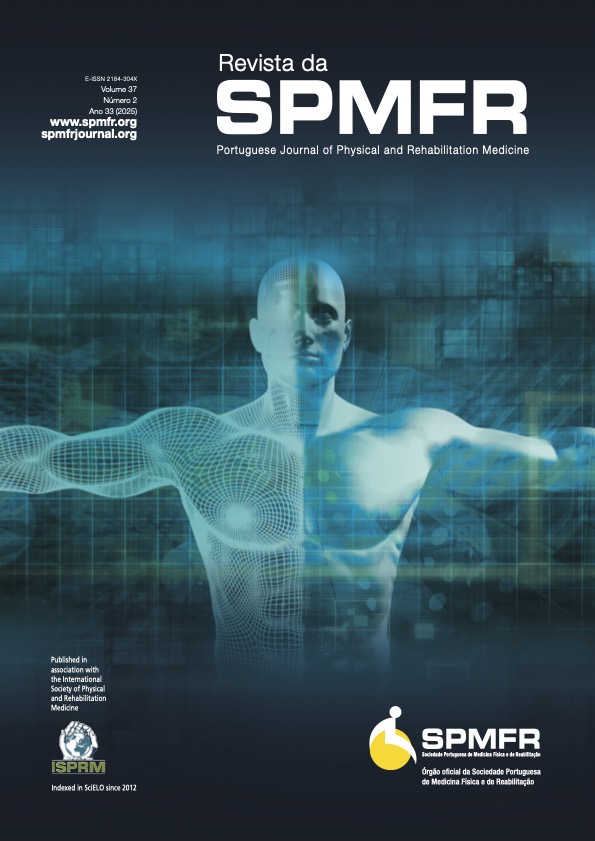Impact Of Incontinence On Healthcare Professionals: Highlighting The Imperative For Increased Awareness
DOI:
https://doi.org/10.25759/spmfr.511Keywords:
Urinary Incontinence, Fecal Incontinence, Health Personnel, TherapeuticsAbstract
Introdução: A incontinência urinária e anal são comuns, embora muitas vezes sub-diagnosticadas, devido ao estigma social associado. Este estudo tem como objetivo identificar a prevalência e o impacto da incontinência urinária e/ou anal nos Profissionais de Saúde Portugueses (PSP) e perceber se o estigma existente na população em geral é também comum neste grupo de profissionais.Métodos: Estudo transversal. Os dados foram obtidos através de um questionário online com o objetivo de caraterizar a incontinência entre os PSP que trabalham num Hospital Público. O inquérito incluiu questões sobre dados demográficos, características da incontinência e o seu impacto na qualidade de vida (QdV), bem como, sobre o tratamento e respetivo efeito, e a procura de cuidados médicos.
Resultados: Foram incluídos 133 PSP , com idade média de 39 anos; 46 (34,59%) referiram incontinência urinária, especialmente de esforço, e 7 (5,26%) referiram incontinência para gases, sendo que 5 destes tinham incontinência anal e urinária. Apenas 17 dos 48 PSP (35,42%) com sintomas de incontinência foram submetidos a tratamento médico, o que resultou numa melhoria média de 3,11 na QdV, (4,22 antes do tratamento versus 7,33 após o tratamento, p<0,001), na Escala Visual Analógica, em que 0 é a pior e 10 é a melhor QdV. Entre os que apresentavam sintomas, mas não procuraram assistência médica, o principal motivo citado foi a vergonha (67,7%).
Conclusão: Apesar de um número considerável de casos de incontinência, muitos PSP não procuram ajuda médica, mesmo considerando que interfere na qualidade de vida. No entanto, a maioria das pessoas que apresentam sintomas de incontinência considera importante a avaliação médica. Sugere-se estratégias para sensibilizar este grupo de profissionais, nomeadamente, através de sessões de formação ou palestras.
Downloads
References
Bardsley A. An overview of urinary incontinence. Br J Nurs. 2016;25(18):S14–21. doi: 10.12988/bjpn.2016.25.18.S14 PubMed
Irwin GM. Urinary incontinence. Prim Care. 2019;46(2):233–42. doi: 10.1016/j.pop.2019.02.004 PubMed-
Pretlove SJ, Radley S, Tooze-Hobson PM, Thompson PJ, Coomarasamy A, Khan KS. Prevalence of anal incontinence according to age and gender: a systematic review and meta-regression analysis. Int Urogynecol J. 2006;17(4):407–17.
Mazur-Bialy AI, Kolomariska-Bogucka D, Oplawski M, Tim S. Physiotherapy for prevention and treatment of fecal incontinence in women: systematic review of methods. J Clin Med. 2020;9(10):3255.
Assmann SL, Keszthely D, Kleijnen J, Anastasiou F, Bradshaw E, Bramigan AE, et al. Guideline for the diagnosis and treatment of faecal incontinence: a UEQ/ESCP/ESNM/ESPCG collaboration. United Eur Gastroenterol J. 2022;10(3):251–86.
Alouini S, Memic S, Couillandre A. Pelvic floor muscle training for urinary incontinence with or without biofeedback or electrostimulation in women: a systematic review. Int J Environ Res Public Health. 2022;19(5):2789.
Aoki Y, Brown HW, Brubaker L, Cornu JN, Daly JO, Cartwright R. Urinary incontinence in women. Nat Rev Dis Primers. 2017;3:17097.
Hu JS, Pierre EF. Urinary incontinence in women: evaluation and management. Am Fam Physician. 2019;100(6):339–48.
Glazener C, Boachie C, Buckley B, Cochran C, Dorey G, Grant A, et al. Conservative treatment for urinary incontinence in men after prostate surgery (MAPS): two parallel randomised controlled trials. Health Technol Assess. 2011;15(24):1–296.
Saadia Z. Relationship between mode of delivery and development of urinary incontinence: a possible link is demonstrated. Int J Health Sci (Qassim). 2009;3(1):11–6.
Nygaard IE, Shaw JM, Bardsley T, Egger MJ. Lifetime physical activity and female stress urinary incontinence. Am J Obstet Gynecol. 2015;213(1):40 e1–10.
Frayman KB, Kazmerski TM, Sawyer SM. A systematic review of the prevalence and impact of urinary incontinence in cystic fibrosis. Respinology. 2018;23(1):46–54
Saldana Ruiz N, Kaiser AM. Fecal incontinence: challenges and solutions. World J Gastroenterol. 2017;23(1):11–24.
Chaichanavichkij P, Hartmann M, Scott SM, Fenton N, Knowles CH, Carrington EV, et al. Evaluating the risk factors for the development of benign disorders of defaecation: a surgical perspective. Tech Coloproctol. 2023;27(10):847–57.
Pizzol D, Demurtas J, Celotto S, Maggi S, Smith L, Angioelli G, et al. Urinary incontinence and quality of life: a systematic review and meta-analysis. Aging Clin Exp Res. 2021;33(1):25–35.
Miner PR. Economic and personal impact of fecal and urinary incontinence. Gastroenterology. 2004;126(1 Suppl 1):58–13.
Flalkow MF, Melville JL, Lentz GM, Miller EA, Miller J, Fenner DE. The functional and psychosocial impact of fecal incontinence on women with urinary incontinence. Am J Obstet Gynecol. 2003;189(1):127–9.
Caruso S, Brescia R, Matarazzo MG, Giunta G, Rapisarda AMC, Cianci A. Effects of urinary incontinence subtypes on women’s sexual function and quality of life. Urology. 2017;108:59–64.
Stederhecht M, Pirhonen J, Bik E, Wilsgaard T, Vonen B, Qian P. Anal incontinence, urinary incontinence and sexual problems in primiparous women: a comparison between women with episiotomy only and women with episiotomy and obstetric and sphincter injury. BMC Women’s Health. 2014;14:157.
Klimaszewska K. The social aspects of urinary incontinence of women. Pielegniarstwo XXI Wieku Nursing in the 21st Century. 2017;16(1):57–61.
Elenskaia K, Haidvogel K, Heidinger C, Doerfler D, Umek W, Hanzai E. The greatest taboo: urinary incontinence as a source of shame and embarrassment. Wen Kin Wochenschr. 2011;123(19–20):607–10.
Thompson DL, Smith DA. Continence nursing: a whole person approach. Br J Nurs. 2007;16(2):14–21.
Bragg R, Hebel D, Vouri SM, Pillick JM. Mirabegron: a beta-3 agonist for overactive bladder [Internet]. Consult Pharm. 2014;29(12):823–37. Available from: http://www.accessdata.fda.gov/scripts/cder/drugsatfda/
Wani MM, Sheikh MI, Bhat T, Bhat Z, Bhat A. Comparison of antimuscarinic drugs to beta-adrenergic agonists in overactive bladder: a literary review. Curr Urol. 2021;15(3):153–60.
Yang SJ, Liu YT, Lo SS, Tsai CC, Pan PJ. Effect of a comprehensive rehabilitation program for community women with urinary incontinence: a retrospective cohort study. Healthcare (Basel). 2021;9(12):1686.
Downloads
Published
How to Cite
Issue
Section
License
Copyright (c) 2025 Revista da Sociedade Portuguesa de Medicina Física e de Reabilitação

This work is licensed under a Creative Commons Attribution-NonCommercial-NoDerivatives 4.0 International License.
Copyright statement
Authors must also submit a copyright statement (as seen below) on article submission.
To the Editor-in-chief of the SPMFR Journal:
The below signed author(s) hereby state that the article
________________________________________ (ref. MFR_________) is
an original unpublished work and all facts stated are a product of the author(s) investigation. This article does not violate any copyright laws or privacy statements. The author(s) also hereby confirm that there is no conflict of interest's issues in this article.
By submitting this article the author(s) agree that after publication all copyrights belong to the SPMFR Journal.
Signed by all authors
Date:
Names (capital letters):
Signatures:
The SPMFR Journal’s contents are follow a Creative Commons licence. After publication the authors can hand out the articles as long as the SPMFR Journal is credited.



